 I was wrong. The kids were right (see previous blog). I was on TV Sunday night. My face was plastered on primetime, beamed into millions of tiny Japanese homes, including the bedrooms of middle schoolers mesmerized that their sensei doubled as a TV star.
I was wrong. The kids were right (see previous blog). I was on TV Sunday night. My face was plastered on primetime, beamed into millions of tiny Japanese homes, including the bedrooms of middle schoolers mesmerized that their sensei doubled as a TV star.
A strange phone call from Kai at Jupiter modeling agency caused me to reverse my conviction that the kids had mistaken my identity. “Jeff-san, I need to get your bank information so that we can pay you ¥3000 in January.”
Caught so off guard, I almost played along. “Umm…actually, you don’t owe me anything. I never did a job for you.” I think I should know. I mean, how could I possibly have appeared on TV in absentia?
Apparently quite easily. All the network needed was a headshot that the agency snapped when I registered in August. Because there is no actors’ guild or modeling union, my likeness can be exploited like a cheap commodity. You play by industry rules, and this network required confidentiality as to which faces had been selected until after airing.
Kai explained that I appeared on TV Asahi’s popular quiz show “iQ.” Japanese contestants are challenged in a game of memory featuring pictures of foreigners. “For Japanese, cannot recognize foreigners – they look the same. Your face came after a German.” 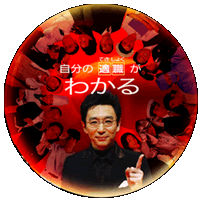 I won’t have to imagine the pained expressions and wild gesticulations of Japanese contestants stumped when faced to recall foreigners. I hope to obtain a complimentary DVD copy of the program. However, part of me feels like a pawn used – without my knowledge or consent – as a means to an end: to boost ratings through humiliation of outsiders. On the other hand, that’s the most effortless $25 I’ll ever pocket.
I won’t have to imagine the pained expressions and wild gesticulations of Japanese contestants stumped when faced to recall foreigners. I hope to obtain a complimentary DVD copy of the program. However, part of me feels like a pawn used – without my knowledge or consent – as a means to an end: to boost ratings through humiliation of outsiders. On the other hand, that’s the most effortless $25 I’ll ever pocket.
Wednesday, November 30, 2005
Rumors Were True
Posted by
ジェフリー
at
9:30 AM
4
comments
![]()
Labels: Modeling
Monday, November 28, 2005
Evolution
 Progress has been slow and all too painful. But seven months into my Japan adventures, I’ve finally found adequate back support for the hours I spend sitting on the computer. From a backbreaking wooden stool to its thinly padded Valentine’s Day kitschy cousin, meet the end-all, be-all: a plush yet robust wooden chair purchased from Muji.
Progress has been slow and all too painful. But seven months into my Japan adventures, I’ve finally found adequate back support for the hours I spend sitting on the computer. From a backbreaking wooden stool to its thinly padded Valentine’s Day kitschy cousin, meet the end-all, be-all: a plush yet robust wooden chair purchased from Muji.
Seat cushions have evolved, too. The latest and comfiest also hails from Muji, and fits squarely on the newest furnishing gracing my 140 square foot palace. This form-fitting foam padding and sturdy lumber chair hopefully spell an end to lumbar agony during lengthy blogging and e-mailing sessions. Now, if I could only do something about those curtains….
In unrelated news, my return to Tokyo after an enjoyable respite in New York was marred by an unusual bomb scare not far from where I work. I first found out about it from Yahoo! news headlines. Don’t miss the other latest national “news” links following the article.
And finally, I need to put an end to some speculation. No, I was not on TV Asahi’s quiz show Sunday night. I let down about a dozen excited Omiyada students today, including one who was “100% sure” that it was I. Perhaps the imposter is the one siphoning my lucrative modeling audition calls. I am placing a ¥1000 ($8.50) bounty for any information leading to his whereabouts.
Posted by
ジェフリー
at
9:20 AM
2
comments
![]()
Thursday, November 17, 2005
Nikko IS Nippon
 Like Kamakura and Kyoto, Nikko is a foreigner’s idealized conception of Japan. Ornate temples, traditional shrines, sculptural trees, and moss-covered statues make it a storybook setting of a bygone era – the early 17th century to be exact. The Nikko-San’nai area is one of Japan’s 12 UNESCO World Heritage Sites, and in autumn Nikko’s structural beauty is matched only by the vivid landscape.
Like Kamakura and Kyoto, Nikko is a foreigner’s idealized conception of Japan. Ornate temples, traditional shrines, sculptural trees, and moss-covered statues make it a storybook setting of a bygone era – the early 17th century to be exact. The Nikko-San’nai area is one of Japan’s 12 UNESCO World Heritage Sites, and in autumn Nikko’s structural beauty is matched only by the vivid landscape.
A scheduling error allowed me to ditch a day of policing Kanokita’s underachievers and instead tour Nikko’s tranquil temples in peak kouyo (literally, “leaves turning red”) season. Nikko was in full bloom in November, a month after the Lake Chuzenji trip.
An older Japanese man asked to sit beside me on the early morning Nikko-bound train that first stopped in Tochigi, his home. Eager to speak English, he shared a throat lozenge and stories from visiting New York five years ago. I asked what he was doing in Tokyo overnight. Apparently, his pension didn’t give him enough money to “play.” I raised my eyebrows when he told me that he drove a taxi in Tokyo “twice a day in one week.”
To come across a driver who speaks English is like finding a seat on the Yamanote Line. Not that I’ve ever tried asking around, as the meter starts at more than my bento box dinner costs – ¥660 ($5.60). The size and jumbled layout of metropolitan Tokyo has got to make it the world’s most challenging taxi driver job.
Yet, I broke free of this congested city for another refreshing outing in the countryside. The air was crisp, but the sun warmed my hands. The sky was blue. The leaves were red, yellow, orange, and green. Sunshine illuminated fall in its most colorful moment while I wandered around some of Japan’s most acclaimed attractions.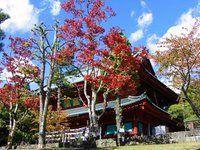 Rinno-ji. My first stop included Eastern Japan’s largest wooden structure, Three Buddha Hall, which houses – you got it – three large golden statues inside.
Rinno-ji. My first stop included Eastern Japan’s largest wooden structure, Three Buddha Hall, which houses – you got it – three large golden statues inside.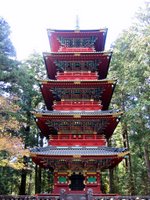 Five-Storied Pagoda. This is another postcard image of Nikko. I also saw a great marketing opportunity for Vodafone to increase its spotty coverage by converting the spire into a cell tower.
Five-Storied Pagoda. This is another postcard image of Nikko. I also saw a great marketing opportunity for Vodafone to increase its spotty coverage by converting the spire into a cell tower.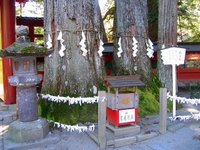 Futarasan Shrine. Nikko’s oldest structure (rebuilt in 1619) is dedicated to the area’s three holy mountains, including Nantai-san. The forest backdrop was especially peaceful.
Futarasan Shrine. Nikko’s oldest structure (rebuilt in 1619) is dedicated to the area’s three holy mountains, including Nantai-san. The forest backdrop was especially peaceful. 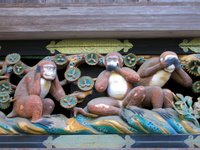
Tosho-Gu. With 55 buildings, this complex is the largest and home to perhaps Nikko’s most famous feature – woodcarvings of monkeys above the Sacred Stables. The three monkeys that depict the “hear no evil, see no evil, speak no evil” principle of Tendai Buddhism are better known than the prime minister. Let’s just say that the hype is just that; I prefer their San Francisco counterparts.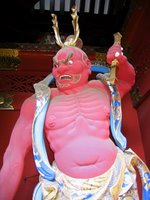 Taiyuin-Byo. Tomb of the third Tokugawa Shogun, Tokugawa Iemitsu, is a damn good place to rest in peace. The mausoleum is a grandiose yet impeccably designed complex on the forested edge of Nikko. The afternoon sunlight percolated through towering cedars hiding this jewel. When my number is up, someone please dig a hole for me here.
Taiyuin-Byo. Tomb of the third Tokugawa Shogun, Tokugawa Iemitsu, is a damn good place to rest in peace. The mausoleum is a grandiose yet impeccably designed complex on the forested edge of Nikko. The afternoon sunlight percolated through towering cedars hiding this jewel. When my number is up, someone please dig a hole for me here. Shin-Kyo. This vermillion icon, the Sacred Bridge of Nikko, is in reality a puny disappointment. Rather than pay to cross its 100-meter expanse, I opted to photograph it from the shoulder of the four-lane highway running beside it.
Shin-Kyo. This vermillion icon, the Sacred Bridge of Nikko, is in reality a puny disappointment. Rather than pay to cross its 100-meter expanse, I opted to photograph it from the shoulder of the four-lane highway running beside it.
I quickly moved on to Kanman Ga Fuchi. This is an easy hiking trail through a Stone Park lined with weathered statues of Jizo, the guardian of deceased and unborn children, pregnant women, and travelers. The adjacent river completed the timeless setting.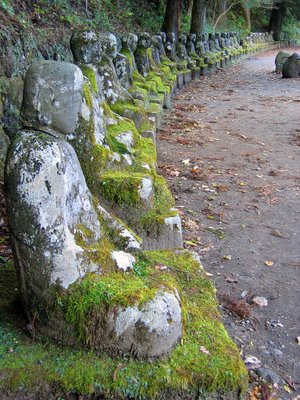
Tourism posters proclaim “Nikko IS Nippon [Japan].” Nikko wo minakereba “kekkoh” to iu na is a famous expression that translates to “Don’t say ‘magnificent’ until you’ve seen Nikko.” Another dimension to this Japanese pun is “See Nikko and say ‘enough.’” I say, Juu-ichi gatsu no Nikko wa gen so tekki desu. Nikko in November is magical.
Blogger’s Note: I’m leaving all things Japan behind for one week to celebrate Thanksgiving in New York. Sayonara bento box, it’s turkey time! Expect the next entry to appear after 11/28.
Posted by
ジェフリー
at
4:00 PM
1 comments
![]()
Labels: domestic travel
Tuesday, November 15, 2005
Lake in the Mountains: Chuzenjiko
 Nostalgic of New Hampshire autumns, I ventured two hours north of Tokyo to the temple-studded town of Nikko. Bestowed with UNESCO World Heritage status in 1999, Nikko is also a gateway to a large National Park.
Nostalgic of New Hampshire autumns, I ventured two hours north of Tokyo to the temple-studded town of Nikko. Bestowed with UNESCO World Heritage status in 1999, Nikko is also a gateway to a large National Park.
Nikko’s leaves were still green in mid-October, so my Japanese friend Makiko and I pushed another hour west into the mountainous Lake Chuzenji region, about 1270 meters (4167 ft.) above sea level. The coach bus navigated Irohazaka winding road and its 30 hairpin curves. Trees ringing the lake, however, were only just beginning to bare their fall coats.
Nearby roared Kegon no taki, considered one of the three most beautiful waterfalls in Japan. Water cascaded 97 meters (318 ft.) into the mist below. Instead of taking the traditional leap like lovers with no prospect of marriage, we hopped aboard another bus to transport us 15 miles deeper and higher up into the woods.
Our pursuit of peak foliage ended at Kotoku Onsen. We followed a trail lined with birch trees. The air was redolent of wet bark. I inhaled the scents of fall. Finally, I had found nature in Japan, and escaped the endless urban landscape of concrete apartment buildings that matches October’s overcast skies. The dirt path led to an elevated track through the woods. The trees thinned to reveal a field walled in by mountains ablaze in seasonal color. A cloud belt encircled the midsection of Nantai-san (2484 m., 8150 ft.). This sacred mountain is the topographical godfather of the region. Now an extinct volcano, its lava flows created Lake Chuzenji by damming up a river.
The dirt path led to an elevated track through the woods. The trees thinned to reveal a field walled in by mountains ablaze in seasonal color. A cloud belt encircled the midsection of Nantai-san (2484 m., 8150 ft.). This sacred mountain is the topographical godfather of the region. Now an extinct volcano, its lava flows created Lake Chuzenji by damming up a river.
Sunshine pierced fast-moving storm clouds to ignite the dried pampass grass field of Senjogahara. The wheat-like stalks contrasted with the dramatic patchwork of color in the mountains. Birch trees rose from these alpine marshlands in the watchful shadow of Nantain-san. These shirakamba are known as “noble women” of Senjogahara plateau. Their slender, white figures make shirakamba a fitting description. I could have spent the whole afternoon soaking up a setting reminiscent of New England.
A school trip of spirited 11-year-olds was taking the same hike. For once, the kids were clad in their choice of mismatched sportswear, and not school uniforms that make them look like naval cadets. My passive serenity as a day hiker disappeared. The shift to energetic schoolteacher was automatic. We traded greetings in both languages, and I handed out a few high-fives. A boy wearing a Yakult Swallows hat grinned when I began rattling off their roster. “Now I know what you are like in school,” Makiko smiled.
Ryuzu Falls marked the end of our forest wandering, and the beginning of a late afternoon downpour. Ryuzu’s water flows 210 meters (689 ft.) and feeds Lake Chuzenji. The deck from a nearby teahouse provided views of the foot of the falls, where rocks split the stream of water. The formation is said to resemble the head of a dragon, from which the falls take their name.
The hike worked up an appetite. The local specialty of yuba, thin layers of coiled bean curd, was a meaty supplement to ramen. Makiko said the succulent skewers of yakitori were among the best she’s had. For dessert, it was blueberry soft serve and a bag of addictive potato chips for the train ride home. Flavored with rich Hokkaido butter, they are only available during fall, so I’ve begun stocking up for the long winter ahead.
Foliage is the best thing about fall. To seek nature is the best reason to leave Tokyo. It wouldn’t be long before I returned to visit Nikko itself.
Take a hike! Well, a virtual one.
Posted by
ジェフリー
at
4:15 AM
1 comments
![]()
Labels: domestic travel
Thursday, November 10, 2005
Kids Say the Darn’dest Things
 After about 50 self-introductions, I’ve finally finished introducing myself to all classes at the four junior high schools. It only took six months. I’ve compiled the top 20 questions they asked following my self-introduction. Their provocative queries and my honest responses are below:
After about 50 self-introductions, I’ve finally finished introducing myself to all classes at the four junior high schools. It only took six months. I’ve compiled the top 20 questions they asked following my self-introduction. Their provocative queries and my honest responses are below:
20. What is your best time in the 100-meter dash?
Slow.
19. What’s your salary?
Peanuts.
18. Who is the prettiest teacher at this school?
Next question, please. [What I wanted to say: They’re all over the hill, so the prize goes to the principal’s 25-year-old acne-cheeked secretary who dresses in skimpy bedclothes.]
17. Do you own a gun?
No, but in Thailand I shot a crossbow at a jackfruit.
16. Is it true that it is prohibited to wear a hood in front of black people?
Unless it’s a white hood, you’ve been watching too much terebi.
15. Is English of black people different?
Hip-hop music video lyrics may not match vocabulary contained within your Let’s Talk textbook.
14. Have you met Arnold Schwarzenegger?
No, but does Bill Clinton count?
13. How did you get so tall?
By studying so hard, my brain grew and so did the rest of my body.
12. What are the positives and negatives of having a high nose?
Probably the same as having slanty eyes.
11. Have you ever seen a UFO?
No UFOs, but betcha didn’t know your teacher was an illegal alien.
10. Do you like our class more than your mother?
No, my mom makes me delicious smoothies.
9. Where was your first kiss?
[Ruled taboo by Japanese teacher.]
8. What kind of woman do you like?
[Scanning brain for PG-13 adjectives]…I like a smart woman.
7. At what temperature do you have your bath?
I take showers, but thanks.
6. Do you like whisky?
No.
5. Chicken, beef, or pork?
Pork, but I try to keep kosher.
4. Can you eat five cakes in one day?
You know, not all Americans are pigs.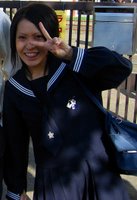
3. What is your blood type?
Unsure. [Blood type here indicates compatibility or personality, like a zodiac sign].
2. I want to go to New York. What is your telephone number?
In New York or Tokyo? 080-30**-**** [cut off by Japanese teacher].
1. Will you marry me if I become the Prime Minister of Japan?
Mochiron! Of course!
Posted by
ジェフリー
at
10:30 AM
4
comments
![]()
Labels: teaching (general)
Saturday, November 05, 2005
Halloween: Octopus, Medusa and Manslaughter
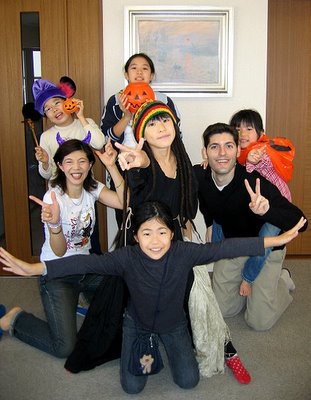 Holidays offer the chance to substitute the usual textbook drivel with creative lessons. In Japan, Halloween passes with little fanfare, except for at establishments catering to boozing foreigners. With some students only vaguely aware of the traditions, I kicked off classes by bringing the ghoulish cast of characters to life through colored chalk.
Holidays offer the chance to substitute the usual textbook drivel with creative lessons. In Japan, Halloween passes with little fanfare, except for at establishments catering to boozing foreigners. With some students only vaguely aware of the traditions, I kicked off classes by bringing the ghoulish cast of characters to life through colored chalk.
This created immediate cross-cultural confusion. After I sketched a ghost, a boy shouted out “octopus,”  so I added feet, only to draw more laughs – ghosts in Japan don't have them. I guess that’s also true of their American counterparts. Students guessed “bones” for my rendition of a skeleton. I then explained the superstition of black cats, which happens to be the name and logo of a parcel delivery service here.
so I added feet, only to draw more laughs – ghosts in Japan don't have them. I guess that’s also true of their American counterparts. Students guessed “bones” for my rendition of a skeleton. I then explained the superstition of black cats, which happens to be the name and logo of a parcel delivery service here.
A witch flying on a broomstick by moonlight was easily identified, so I went a step further to rile up the crowd. Straddling a broom borrowed from the class cleaning closet, I hopped across the room letting lose a high-pitched cackle. Even the sleeping kids (there’s always one or two) awoke to see the commotion. One boy in the front row started crying because he couldn’t stop laughing.
Trick-or-treating posed a challenge to explain. I acted it out by weaving a garbage pail through the aisles of desks, knocking on a few to ask for chocolate and candy. I got only blank stares in return, so the Japanese English teacher stepped in to translate.
At Kanokita School, Mr. Mochizuki shared a grisly Halloween story from 1992 when a 16-year-old Japanese exchange student in a white disco costume rang the wrong doorbell in search of a Halloween party in Baton Rouge. The startled proprietor yelled, “freeze,” but the boy mistook the command for “please,” and approached the man wielding a .44 Magnum, which he unloaded into the trespasser’s chest.
This tragedy reinforces the Japanese stereotype of trigger-happy Americans. Mr. Mochizuki was always dredging up the issue of guns in America, and capitalized on an incident that hit close to home to prove American barbarism. Arms folded, I held back disgruntlement and leaned against the door, watching young grins turn upside-down. We all gasped at the story’s exclamation point: 31-year-old Rodney Peairs was acquitted of manslaughter. I regained the floor and quickly shifted gears to build up anticipation for the unveiling of my Halloween costume, a Rastafarian wig friends purchased while vacationing in Jamaica. Scattered cheers answered my call for, “Do you want to see my costume?” so I excused myself and ducked into the hallway to throw on dreadlocks. I looked both ways to avoid embarrassment in front of Halloween-unaware teachers, or worse, district education officials on the lookout for signs of progress in the chaos at Kanokita.
I regained the floor and quickly shifted gears to build up anticipation for the unveiling of my Halloween costume, a Rastafarian wig friends purchased while vacationing in Jamaica. Scattered cheers answered my call for, “Do you want to see my costume?” so I excused myself and ducked into the hallway to throw on dreadlocks. I looked both ways to avoid embarrassment in front of Halloween-unaware teachers, or worse, district education officials on the lookout for signs of progress in the chaos at Kanokita.
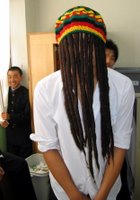
 What the heck was sensei wearing on his head? The puzzling costume produced amusing guesses, most commonly that I was a girl. Other mistaken identities included, Mexico, Medusa, and tree roots. One girl was in favor of the new look: “it suits you,” she said. The girls wanted to touch my locks while the boys wanted to try on the wig, which played perfectly into my plan of getting photo-ops.
What the heck was sensei wearing on his head? The puzzling costume produced amusing guesses, most commonly that I was a girl. Other mistaken identities included, Mexico, Medusa, and tree roots. One girl was in favor of the new look: “it suits you,” she said. The girls wanted to touch my locks while the boys wanted to try on the wig, which played perfectly into my plan of getting photo-ops.
The dreads shed and scratched, but I kept the wig on for the duration of the class for amusement’s sake. I tied the hair into a bun to get it off my shoulders. Sometimes I pretended to eat it. Sticking a dreadlock inside each nostril was a crowd pleaser.
In religious holiday news, on October 13 I informed Mr. Mochizuki that I would not be eating lunch with the children that day. I would not be eating lunch at all because of Yom Kippur, the Jewish Day of Atonement.
No, I was not on a diet, did not have a stomachache, and was not about to undergo a medical procedure. Explanation of why I was fasting was more difficult to translate than what the students surmised.
Although not religious, I make an effort on the holiest day of the Jewish calendar. But neither Jews nor Judaism rang a bell with Mr. Mochizuki. Not even after looking up the translation in the dictionary. After I convinced him that Judaism was not a sect of Christianity, he asked, “Are you Islam?”
I groaned silently, and tried a different tactic. “Do you know the country of Israel?” No. “How about the Holocaust?” Curious stare. “You know, how Hitler killed 6 million people in Europe, and well, most of them were Jews?” “Ahh, okay,” the teacher said, as if recalling some trivial factoid from the recesses of his brain. “Please tell the children some information.” “About the Holocaust!?” Thankfully, classes last only 50 minutes.
Around the corner is Thanksgiving, which while my favorite holiday on the calendar of either country, is rather boring to explain to Japanese students. We consume truckloads of turkey and harvest vegetables in the company of our dysfunctional extended families. Scrawling a turkey on the blackboard invited creative interpretations of Thanksgiving’s iconic bird, but fortunately peacock, ostrich, and pigeon do not make the menu at my family’s dinner. Pigeon pie, anyone?
Posted by
ジェフリー
at
8:45 AM
4
comments
![]()
Labels: Mochizuki, teaching (general)


